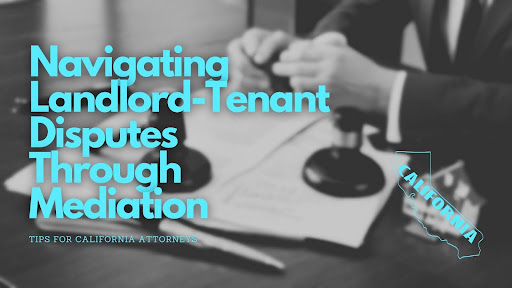Landlord-tenant disputes are a common occurrence in California’s bustling real estate market. As the legal landscape evolves, landlord-tenant mediation has emerged as an effective tool for resolving these conflicts efficiently and amicably.
This comprehensive guide provides California attorneys with essential tips for navigating the California housing mediation process in landlord-tenant disputes, ensuring optimal outcomes for their clients.
Understanding California’s Landlord-Tenant Mediation Landscape
California’s approach to landlord-tenant disputes has undergone significant changes in recent years. The state’s commitment to alternative dispute resolution is evident in various statutes and regulations that encourage mediation. For instance, the California Evidence Code sections 1115-1128 govern the confidentiality of mediation proceedings, ensuring that discussions during mediation cannot be used in court.
At Resolve Wannon, our experienced mediators are well-versed in the nuances of California’s landlord-tenant laws and can guide parties through the California housing mediation process to reach mutually beneficial resolutions. Contact us at 310-592-4359 to learn more about our landlord-tenant mediation services.
Key Benefits of Mediation in Landlord-Tenant Disputes
Landlord-tenant mediation offers several advantages over traditional litigation:
- Cost-effective: Mediation is typically less expensive than court proceedings
- Time-efficient: Disputes can often be resolved more quickly through mediation
- Confidential: Mediation discussions are protected by law
- Flexible: Parties have more control over the outcome compared to court decisions
- Relationship-preserving: The collaborative nature of mediation can help maintain landlord-tenant relationships
Preparing for Landlord-Tenant Mediation
Effective preparation is crucial for successful landlord-tenant mediation. California attorneys should consider the following steps:
- Thoroughly review the lease agreement: Familiarize yourself with all terms and conditions, paying special attention to clauses related to dispute resolution.
- Gather relevant documentation: Collect all pertinent records, including rent payment history, maintenance requests, and correspondence between parties.
- Understand local regulations: Be aware of specific landlord-tenant laws in the relevant California jurisdiction, such as the Tenant Protection Act of 2019 (AB 1482).
- Prepare your client: Discuss realistic expectations and potential outcomes with your client before entering mediation.
Navigating the California Housing Mediation Process
The California housing mediation process typically follows these steps:
- Initiation: Either party can request mediation, often as stipulated in the lease agreement.
- Mediator selection: A neutral third-party mediator is chosen, often from a court-approved list or through mutual agreement. At Resolve Wannon, our skilled mediators are ready to assist in resolving your landlord-tenant disputes.
- Pre-mediation conference: The mediator may hold a preliminary meeting to explain the process and set ground rules.
- Mediation session: Parties present their perspectives and work towards a mutually acceptable solution. California Rules of Court Rule 3.857 outlines the quality standards for the mediation process, ensuring procedural fairness and balanced participation.
- Agreement drafting: If a resolution is reached, the terms are documented in a binding agreement.
Effective Strategies for Landlord-Tenant Negotiation in California
To maximize the chances of a successful landlord-tenant mediation, consider these landlord-tenant negotiation strategies:
- Focus on interests, not positions: Encourage parties to express their underlying needs and concerns rather than rigid demands.
- Explore creative solutions: Be open to unconventional resolutions that address both parties’ interests.
- Utilize caucus sessions: Private meetings with the mediator can help clarify positions and explore settlement options.
- Leverage California-specific remedies: Be familiar with state-specific options, such as the repair-and-deduct remedy under California Civil Code § 1942.
Protecting Tenant Rights in California Mediation
While landlord-tenant mediation aims for a balanced resolution, it’s crucial to ensure tenant rights mediation in California is protected throughout the process. Key considerations include:
- Implied Warranty of Habitability: Ensure compliance with California Civil Code § 1941.1, which outlines minimum standards for residential rentals.
- Security Deposit Regulations: Be aware of limitations on security deposits as per California Civil Code § 1950.5.
- Retaliation Protections: Familiarize yourself with anti-retaliation provisions under California Civil Code § 1942.5.
Post-Mediation Steps and Enforcement
If a settlement is reached, take these important steps:
- Draft a clear, comprehensive agreement: Ensure all terms are unambiguous and enforceable under California law.
- File the agreement with the court: If applicable, submit the mediated agreement for court approval.
- Monitor compliance: Establish a system to track adherence to the agreed-upon terms.
- Be prepared for enforcement: Understand the process for enforcing mediated agreements under California Code of Civil Procedure § 664.6.
Conclusion
Landlord-tenant mediation offers a powerful tool for resolving landlord-tenant disputes in California. By understanding the California housing mediation process, preparing thoroughly, and employing effective landlord-tenant negotiation strategies, attorneys can guide their clients towards mutually beneficial resolutions.
As the legal landscape continues to evolve, mastering the art of mediation will be increasingly valuable for California attorneys specializing in landlord-tenant law.
If you are seeking expert landlord-tenant mediation services for your landlord-tenant dispute, contact Resolve Wannon at 310-592-4359. Our experienced mediators are dedicated to helping parties find fair and amicable resolutions.
Landlord-Tenant Mediation FAQs: Your Questions Answered
Q: How long does landlord-tenant mediation typically take in California?
The duration varies, but most mediations are completed within 1-3 sessions, each lasting 2-4 hours.
Q: Is mediation mandatory for landlord-tenant disputes in California?
While not universally mandatory, many lease agreements and some local ordinances require attempted mediation before litigation.
Q: Can a tenant bring a support person to mediation?
Yes, tenants (and landlords) may bring a support person, but their role is usually limited to moral support rather than active participation.
Q: Are mediated agreements legally binding in California?
Yes, when properly drafted and signed, mediated agreements are legally binding and enforceable under California law.
